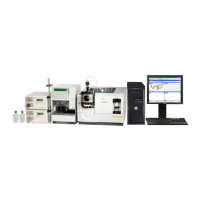The Pole-Zero Equation
To express your transfer function in pole-zero format, use the following
formula:
H(s) = K
where * is the conjugate
KisthesystemGain
P is the pole position ( -σp±jBp)
Z is the zero position ( -σ
z
±jΒ
z
)
This formula is the basis for interpreting pole-zero data in the synthesis table.
Pole and zero positions are in Hertz. During synthesis, the analyzer replaces s
with jf (where f is frequency in Hertz).
sZsZ sZ sZ
sPsPsPsP sP
n
m
−−− −
−−−− −
∗
122
1233
a
f
a
f
a
f
a
f
afafafafa f
...
...
Pole-Zero Data
This is how pole-zero data appears in a synthesis table:
where: pole and zero terms are in Hz
(thus, frequency scale = 1.0 will be used)
Hs
s
ss js j
()
()
()( )( )
=
×+
++− ++
1 10 600
250 500 2000 500 2000
6
POLES 3 SYNTH ZEROS 1
-250
-500 j2e+3
-600
TIME DELAY=0 s
FREQUENCYSCALE=1
GAIN=1e+06
-250
Agilent 35670A
Operator's Guide Synthesis Option 1D3
15-5
